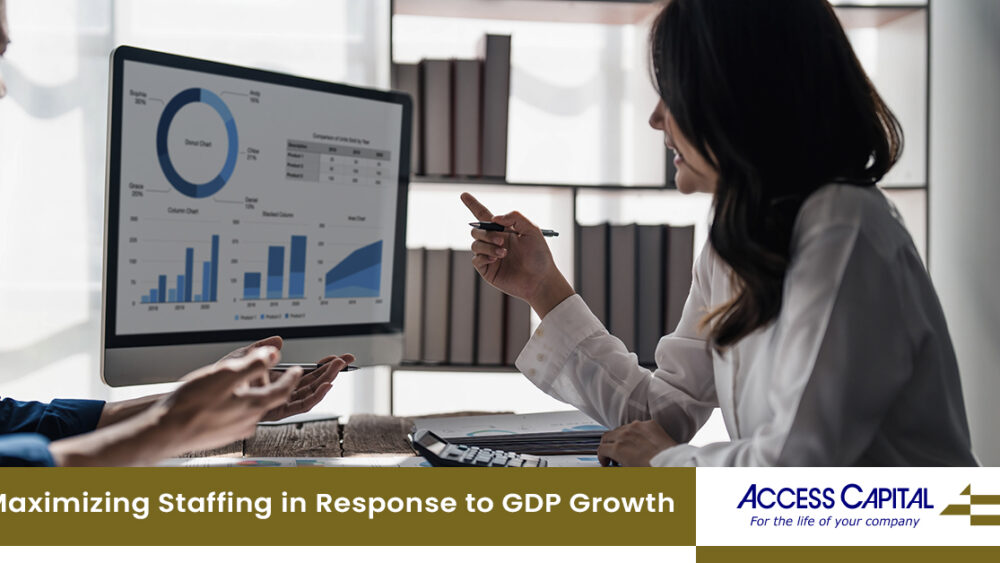Understanding the correlation between GDP growth and staffing demand has never been more crucial for staffing executives. This blog explores how recent economic phenomena, influenced by the pandemic and resulting policies, have reshaped the dynamics between GDP and staffing requirements. We’ll delve into the impacts of technology adoption, remote work trends, and changes in worker behavior, providing you with a comprehensive framework to navigate these changes effectively.
The Link Between GDP Growth and Staffing Demand
Historically, GDP growth has been a reliable predictor of staffing demand. A booming economy typically signals more business activities, project expansions, and consequently, an increased need for staffing. Companies in a growing economy generate more jobs, fueling demand for both permanent and temporary staffing solutions. However, recent events have introduced complexities in this correlation.
Economic Volatility and the Pandemic’s Impact
The COVID-19 pandemic brought unprecedented volatility, severely impacting GDP and, in turn, staffing demands in ways not previously witnessed. While healthcare sectors saw a surge in temporary staffing needs due to emergency responses, industries like hospitality experienced significant downturns. The swift changes in employment, driven by lockdowns and subsequent economic reopening, have created a new pattern of staffing demands that traditional economic models, like GDP growth, could not predict accurately.
Government Policies and Economic Interventions
The pandemic era saw extensive government interventions through stimulus packages aimed at stabilizing the economy and preserving jobs. These measures, while temporary, altered the typical dynamics between GDP and staffing needs. For instance, enhanced unemployment benefits provided a cushion that decelerated the urgency for many to return to work, thus affecting the staffing industry’s usual supply dynamics.
Navigating the Post-Pandemic Recovery
As economies rebound, the relationship between GDP growth and staffing demand is beginning to normalize, albeit with emerging new patterns. The recovery has been uneven across sectors, with some experiencing rapid resurgence and others lagging. This phase has highlighted the necessity for staffing firms to adapt to new market conditions and worker preferences, such as the growing demand for remote work opportunities.
The Role of Technology and Remote Work
- Technology Adoption: Digital transformation across industries means new types of jobs and required skills are emerging. Staffing firms must adapt by understanding these technologies and aligning candidate sourcing to meet these new roles. AI and automation are reshaping the demand landscape, shifting it towards more specialized and creative tasks.
- Remote Work Trends: The expansion of remote work has broadened the talent pool, allowing staffing firms to source candidates globally. This shift necessitates adjustments in recruitment strategies, focusing on digital engagement and competencies suited for remote work environments.
Changes in Worker Behavior and Preferences
- Shift in Worker Preferences: The post-pandemic world sees a shift towards flexible work arrangements. Staffing firms must respond by offering varied employment forms to meet these expectations, emphasizing work-life balance and job meaningfulness.
- Health and Safety Priorities: Ongoing health concerns mean candidates prioritize workplace safety and supportive environments more than ever. It’s crucial for staffing firms to ensure their placements meet these standards to attract and retain talent.
Sector-Specific Economic Recovery
Understanding the differential recovery rates across sectors can enable staffing firms to allocate resources more effectively. Sectors like technology and healthcare might offer more opportunities due to faster recovery rates compared to more traditional fields like retail or hospitality.
Strategic Implications for Staffing Firms
- Proactive Adaptation: Staffing firms should not only react to changes but also anticipate and prepare for future shifts. This may include forming strategic partnerships or diversifying service offerings.
- Data-Driven Decision Making: Utilizing data analytics to understand market trends can greatly enhance a staffing firm’s agility and responsiveness. This approach allows firms to predict staffing needs more accurately and tailor their strategies accordingly.
Seizing Opportunities: Your Partner in Growth
It’s crucial for staffing executives to extend their vision beyond traditional metrics such as GDP growth. By integrating comprehensive analyses that consider economic indicators, technological advancements, and shifts in worker behaviors, your staffing firm can strategically position itself to meet both current and future market demands, enhancing your resilience and relevance.
Access Capital stands ready to be that partner. With our deep understanding of the staffing industry’s unique challenges and opportunities, coupled with our tailored financial solutions, we are poised to support your journey toward robust business growth.




